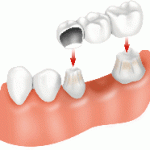There is no exact figure regarding the success rate of crown and bridges. According to some surveys, small conventional bridges can last around 20-40 years where as larger conventional bridges can last 10-30 years. For adhesive bridges, they last approximately 10-20 years or more. Evidences to prove the success rate for adhesive bridges are not very strong due to they are being introduced long time after conventional rate. Success rate of bridges depend strongly on the maintenance by the patient him/herself.
There are few causes of failure of bridges:
1)Â Â Â Â Â Loss of retention
Retainer of the bridges (which is the metal part that you can observe from your bridges) which became loose after some time might cause the failure of the fixed prosthesis. Furthermore, plaque might accumulate at the area and caries can develop at the surface of tooth preparation. To check whether the bridge retainer is loose, your dentist will press the bridge up and down, if there is looseness, there will be small bubbles at the margins of the retainers.
For adhesive bridges, recementation of bridges are possible but you must be reminded that theres possibility that it will come off anytime later.
2)Â Â Â Â Â Mechanical failure :
Porcelain fracture:Â It is very common , for short term wise, one of the solution is to replace the fracture part with composite as it is more cost effective for the patient but the composite will discolored after few years and it might be a hazard for the patient to replace the restoration.
To avoid this problem, the metal of the bridge should be adequate thickness to avoid distortion.
3)Â Â Â Â Â Failure of connectors :
Connectors are the one who join the pontic (artificial tooth) to the retainer ( crown/other restoration that is cemented to the abutment). Failure of connectors might be the failure of the metal itself or failure to bond to the metal framework. Normally the whole bridge must be remove and remade for this situation.
4)Â Â Â Â Â Distortion :
Distortion of bridges can occur due to trauma and thin framework or inadequate length of framework for a large space/span  to be replaced.
5)Â Â Â Â Â Occlusal wear and perforation
This might happen after the bridge is constructed for a long time. Normally dentist will place an appropriate restoration on the perforation .
After a long time, periodontal disease might developed around the abutment teeth. For early periodontal disease , no treatment is needed but for advanced periodontal disease, the bridge should be removed. No bridge should be constructed for patients who have excessive bone loss and advanced periodontal disease because prognosis for the bridge will be poor.
The tooth might be non vital after being prepared. Root canal treatment can be done might accessing from the top of the crown but the overlying crown might mask the real anatomy of the underlying tooth and by accessing the crown, it might weaken the core . For teeth which has been root filled before, if there is problem, shortening of the roots might be a good idea.
As we had mentioned earlier, caries might develop at the surface of tooth which has been prepared. Movement of the abutment tooth might occur after sometime, due to periodontal disease and the bridge might become loose.
Sometimes, it might be a failure from the beginning where the constructed bridge is not well adapting to the prepared tooth. Marginal deficiencies of the bridge may occur or theres defect on the bridge at the time it was being constructed. The design of the bridge might be poor at first. This can or contribute to the bridge failure.
The severity of bridge failure is accessed before the dentist determine whether replacement / adjustments are to be done. Sometimes, it is best to leave it alone if it doesn’t cause harm or damage. Small repairs can be done and it is cost effective , such as amalgam on the surface of metal retainer, composite on the porcelain but dentist should always check the restored part periodically. If the bridge has to be removed, multiple parts of the bridge can be divided to smaller sections to ease the removal. If the abutment tooth is to be extracted, we can just remove using a bridge removal as it is faster. For bridge to be removed intact, we can try to remove using a sharp tapping to fracture the cement lute or using slide hammer to remove it. Methods to remove bridges depend on the dentist him/herself.
To conclude, success of a bridge depends on several parties. Cooperation from the patient, good clinical skills from the dentist, good laboratory work from the technologist.
